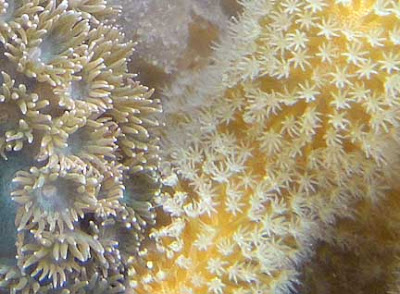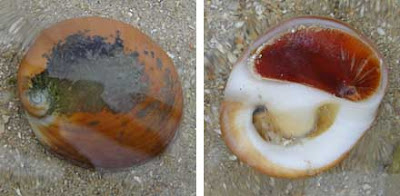 |
| This amazing reef lies just opposite the world-class container terminals at Pasir Panjang. |
Here is HRH Siti doing the royal wave as Melvin takes the first group to land on Cyrene, just emerging out of the water on the horizon.
Zeehan from NUS leads her student Chun Keat and his helpers in their survey for an invasive goby. Collin from NParks is with them also to find out what fishes can be found on Cyrene. Thankfully, they didn't find any invasive gobies, but did find lots of other native fishes. What is an invasive species and why is it important to look out for them? More in this post.
Siti heads off with Jerome to set up some experimental structures to learn more about seagrasses on Cyrene.
Rachel from NParks and her helper are checking up on GIS data for Cyrene. They walk the length of the 1km submerged reef. The enormous container ship gives an idea of how large Cyrene is!
My job is to look out for fish traps and driftnets abandoned on Cyrene as part of Project Driftnet. It was a relief to find no newly abandoned traps or nets. The only nets I came across were already well overgrown with marine life, with the netting already degraded, leaving only the ropes. These we leave behind as they don't pose a great danger to marine life and are already part of the ecosystem.
In the process, I also check the reefs to see how they are recovering from coral bleaching. More about coral bleaching on Bleach Watch Singapore. How nice to see happy and healthy corals! Here's a Flowery disk coral (Turbinaria sp.) and a Leathery soft coral (Family Alcyoniidae).
Here's a closer look. The Disk coral is a hard coral with large polyps (on the left) while the Leathery coral is a soft coral with tiny polyps.
I saw an unbleached Cauliflower coral (Pocillopora sp.) and Sandpaper coral (Psammocora sp.). These two species suffered badly during the bleaching event last year.
Also several unbleached Anemone corals (Goniopora sp.) and Small goniopora corals (Goniopora sp.).
I saw several Thin disk corals (Turbinaria sp.) which seemed more or less ok.
There were several unbleached Asparagus soft corals (Family Nephtheidae) and a large patch of Black-and-white leathery soft corals (Cladiella sp.).
I saw many unbleached Pore corals (Porites sp.) both large and small colonies.
The most abundant corals were Favid corals (Family Faviidae) which come in all kinds of patterns and colours. I saw many and they were unbleached.
There are lots of Knobbly sea stars (Protoreaster nodosus) out on the reefs, many clasping rocks and corals, perhaps eating something? Collin also saw a small Pentaceraster sea star (Pentaceraster mammilatus).I saw again, the Cushion sea star (Culcita novaeguineae) that Yusoff found during our trip to Cyrene the day before.
Today the reefs were blanketed in a profuse growth of Hairy green seaweed (Bryopsis sp.). This seaweed was also abundant on some parts of the seagrass meadows. There is often a seasonal bloom of this seaweed. I'm not sure that this means exactly for Cyrene. Which is why regular seagrass monitoring is important. TeamSeagrass heads out to check up on Cyrene next month!
In many parts of Cyrene, the Tape seagrass (Enhalus acoroides) is very short with tips which appear brown and burnt. Large areas of have Tape seagrasses of the same short height. It looks as if the meadows had been mown! One possible explanation is that the high sea temperatures that caused coral bleaching also affected the Tape seagrasses which died at the growing point causing the blades to break off. As the Tape seagrasses recover, they are of the same short height. Another reason why seagrass monitoring is useful!
Among the highlights for me was this Snaky sea anemone (Macrodactyla doreensis) which I haven't seen for some time.
In the seagrass meadows, I also saw many little White sea urchins (Salmacis sp.). 'carrying' bits of shell and seagrass to protect themselves.
On the sand bar, it was great to see once again, the Eggwhite moon snail (Polinices albumen) which so far I've only seen on Changi and Cyrene.
As we were leaving, we noticed the many tiny little sea hares on the shore!
There were Hairy sea hares (Busatella leachii) and some were in pairs, with one following another. Getting ready to mate? These slugs are hermaphrodites with both male and female parts. They are said to form mating chains with the one behind acting as male to the one in front acting as female.
There was also another kind of sea hare, the Furry sea hare (Stylocheilus sp.), also in pairs with one 'chasing' after the other. Alas, we didn't manage to see any in actual mating position.
The special find of the day was by Zeehan! She found this Lovenia heart urchin (Lovenia elongata), my first time seeing it on Cyrene! It is usually buried in the sand and this one burrowed very quickly back in.
Cyrene lies in the middle of the "Industrial Triangle", made up of the Pasir Panjang Container Terminals, and massive industrial facilities on Jurong Island and Pulau Bukom. Today there was flaring at the Bukom petrochemical plants, but the flare seems 'clean' without any black smoke rising from the burn.
As usual, Melvin and the crew from Dolphin make sure we get safely off the Reef. With all our gear!
It's always a delight to visit Cyrene! Thanks to everyone for coming to lead and help out in the work on Cyrene!
More about Cyrene Reef!


























